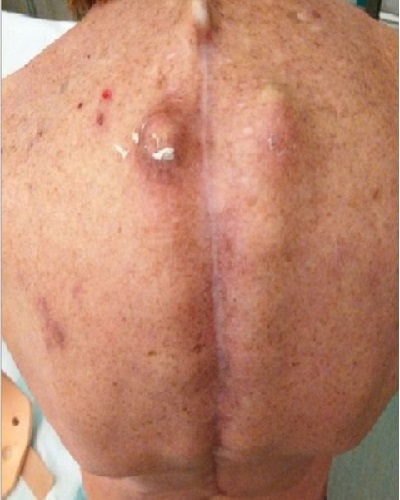Spinal Infection Symptoms & Treatment Options
What is a Spinal Infection?
A spinal infection is a rare, but often serious, form of disease that occurs when bacteria, fungi, or viruses invade the spinal tissues. These foreign agents can attack pretty much any part of the spine that you can image. This includes the vertebrae, spinal discs, meninges, spinal canal… and even the spinal cord.
When these pathogens infect our intervertebral discs, doctors refer to this condition as Discitis, or disc inflammation. When these bugs attack the bones of our spine, we refer to the disease as Osteomyelitis.
Typically, these infections spread to the spine through the bloodstream. Common bacteria, like Staph or E. Coli, can be introduced into the bloodstream following events such as remote surgery, dental extractions or dental procedures, and can also migrate to the spine in the event of infections anywhere in the body, such as ear infections, sinusitis, endocarditis or seen in patients exposed to used or infected needles. On rare occasions people can be exposed to rare pathogens that travel to the spine such as tuberculosis or brucella infections from contaminated food or milk.
Unlike the common cold, which is usually pretty harmless, spinal infections can be serious and potentially life threatening. As spinal discs become inflamed from disease, they may start to break down or even decay. If the vertebral bodies also become infected, then the bones that form your spinal column can crack or fracture. Spinal fractures tend to make the spine very unstable. Unfortunately, this means that the weight of your torso may cause your entire spine to pitch forward. A form of spinal deformity, kyphosis occurs when the thoracic spine (or upper back) develops a forward hump.
Other issues linked to spinal infections include nerve pain and the buildup of pus, known as an abscess. Abscesses—aside from being extremely painful—can place pressure on your spinal cord. Also known as spinal stenosis, narrowing of the spinal canal can lead to nerve pain, muscle weakness, and even paralysis.
Risk Factors & Causes of Spinal Infections
Any event that introduces bacteria into the bloodstream or that weakens the immune system can lead to a spinal infection. For example, those who take immunosuppressants (whether following an organ transplant or to treat an autoimmune disease) often suffer from secondary infections. These can be mild, like a simple cold, or very serious, like osteomyelitis.
In addition, if you have recently undergone spine or pelvic surgery, then your risk of contracting a spinal infection rises steeply. This is true for two reasons. Firstly, surgical instruments and medical devices can introduce germs into the body if they are not properly sterilized. Secondly, your Batson’s plexus (a network of blood vessels) connects your thoracic veins to your pelvic veins, bladder, and prostate. If bacteria from any of these areas infiltrates the plexus, then you can develop a spinal infection.
Via the Batson’s plexus, infections from the bladder (urinary tract infections) or the prostate can also spread to the spine. The risk of developing a secondary spinal infection from a UTI increases tenfold, for example, following a urologic procedure, like a scope.
Infections, like pneumonia and tuberculosis, can also spread to the spine from the lungs. Other diseases that enhance your risk of developing a spinal infection include diabetes, cancer, HIV, and malnutrition. Other events that increase your risk include intravenous drug use, long-term use of steroids, and spinal trauma.
Symptoms of Spinal Infection
The symptoms of a spinal infection tend to develop very slowly. For example, it may take you a week to realize that you’re coming down with a cold. In contrast, spinal infections take between 3 days and 3 months to notice, with an average of a month and a half before detection.
If you suspect that you have a spinal infection, then seek medical attention ASAP. Although many of these infections can be treated with antibiotics: A spine infection is considered to be an emergency. In fact, 20% of these infections will prove to be fatal. To avoid serious complications, seek urgent treatment at your local ER or contact your spine specialist immediately!
How are Spinal Infections Diagnosed?
Spinal Infections can be diagnosed through a combination of imaging studies and lab work. If you are still in the early stages of an infection, your doctor will likely begin by taking an x-ray. Although x-rays cannot show soft tissues (like spinal discs), they can reveal bone deterioration and loss of disc height. (In this case, a loss of disc height is represented by a decreased amount of space between two vertebrae.) To obtain information about both soft tissues and bone health, your doctor may upgrade your exam to an MRI.
Lab work to diagnose a spinal infection may include examining white blood cell count or markers for inflammation. Specifically, these markers are known as the Erythrocyte Sedimentation Rate (ESR) and C-reactive Protein (CRP). These indicators will be unusually high in 85% of all spinal infection cases. In addition, your doctor may also use a blood culture to try to isolate the specific pathogen causing your pain. However, blood cultures are successful at identifying pathogens in less than 50% of spinal infection cases and direct biopsy or sampling might be necessary.
Common Warning Signs Of A Spinal Infection Include:
- Low back pain or neck stiffness
- Fever, chills, or loss of appetite
- Night sweats
- Back pain that is worse at night or doesn’t abate with rest
- Loss of mobility or range of motion
- Redness or warmth at the site of surgical incisions or on the skin’s surface
- Surgical wounds that discharge pus or refuse to heal
More about Dr. Matin
Spinal Infection Symptoms & Treatment Options
Spinal infection can be treated by Dr. Martin, give us a call to schedule an appointment.
We will provide different options of treatment.
Antibiotic Therapy & Bracing
To treat your spinal infection, your doctor will likely use a combination of intravenous antibiotics and bracing to support your spine as it heals. More often than not, this will be sufficient to help you recover.
Laminectomy
If your spinal infection has abscessed, then your surgeon may need to perform a laminectomy to relieve pressure on your spinal cord. During a laminectomy, your doctor will remove the back portion of your vertebra (or lamina) to increase space for your spinal cord.
Lumbar decompression and fusion surgery
During a fusion, your doctor will remove the source of infection from your spine and then perform a spinal fusion. Entering the spine from the front (or anterior side) or from the back side, your surgeon will insert plates, bars and screws that can stabilize your spine and decrease pain while your infection heals
Kyphoplasty
If your vertebra fractured from the infection, then your doctor will need to perform a kyphoplasty, or vertebral augmentation procedure. During this operation, your doctor will remove the infection and inject a medical-grade cement into the collapsed vertebra.






